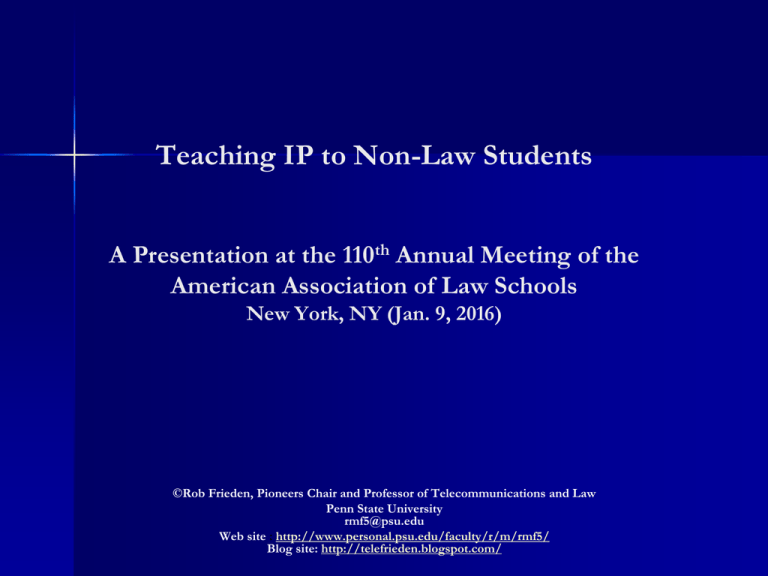Teaching IP to Non-Law Students A Presentation
advertisement

Teaching IP to Non-Law Students A Presentation at the 110th Annual Meeting of the American Association of Law Schools New York, NY (Jan. 9, 2016) ©Rob Frieden, Pioneers Chair and Professor of Telecommunications and Law Penn State University rmf5@psu.edu Web site : http://www.personal.psu.edu/faculty/r/m/rmf5/ Blog site: http://telefrieden.blogspot.com/ The Good News Teaching non-law students, particularly undergraduates, improves one’s breadth and versatility as a teacher. Law professors may gain “brownie points” for delivering on an institutional commitment to interdisciplinarity and “cross pollination.” Undergraduates can remind you of how good you have it in teaching mostly motivated and somewhat intellectually curious students. Teaching non-law students necessitates the exploration and use of different teaching tactics and techniques. Undergraduates can surprise you with their creativity and different perspective. Non-law student teaching can provide an enjoyable alternative to the law school grind. 2 The Bad News Teaching non-law students, particularly undergraduates, exposes extreme weaknesses in American education. Remarkable number of students lacking basic written and oral skills. Far too many lack the motivation to attend regularly and to take notes. Teacher supplied materials considered sufficient. Weakness (if not addiction) to distracting devices and content sources. Millennials have a sense of entitlement, not commensurate with their efforts. Grade inflation has eliminated the complete curve distribution of grades. One can end up devoting much time and effort in finding content and formatting it into slide presentations. Need to migrate students from normative feelings to the rule of law. 3 Strategies for Engaging Non-Law Students Many students outside law schools positively respond to visual, auditory and participatory learning opportunities. While dark rooms and slide packs promote passivity (if not trances and snoring), they can provide an environment for collaboration. Use visual and auditory options, including podcasts, video clips: 4 Strategies for Engaging Non-Law Students 5 Strategies for Engaging Non-Law Students 6 Example of “Blended Learning”—candidate list of links Music and Copyright Links http://www.buzzfeed.com/reggieugwu/what-the-law-says-about-music-plagiarism#.av3ZLRe1P use in class: https://www.youtube.com/watch?v=ziz9HW2ZmmY; or https://www.youtube.com/watch?v=N1KfJHFWlhQ http://blogs.wsj.com/speakeasy/2015/01/26/sam-smith-gives-tom-petty-songwriting-credit-for-stay-with-me/ Sam Smith Stay with Me and Tom Petty I Won’t Back Down combo of Blurred Lines and Got to Give It up https://www.youtube.com/watch?v=CSr8Z7E3w_4 full performance of Got to Give It Up; shorter version: https://www.youtube.com/watch?v=bWAFYYuYbmA http://www.musictimes.com/articles/6250/20140520/7-songs-other-than-stairway-to-heaven-that-led-zeppelin-stole.htm 7 Led Zepplin comparisons https://www.youtube.com/watch?v=3Sdbg2is2zQ https://www.youtube.com/watch?v=xd8AVbwB_6E Stairway to Heaven vs. Taurus (Spirit) http://www.forbes.com/sites/oliverherzfeld/2014/05/21/spirit-v-led-zeppelin-analysis-of-the-stairway-to-heaven-infringement-lawsuit/ Forbes analysis http://fairuse.stanford.edu/overview/fair-use/four-factors/ See more at: http://fairuse.stanford.edu/overview/fair-use/four-factors/#sthash.fw8C7BrS.dpuf Dancing Baby video for test: https://www.youtube.com/watch?v=N1KfJHFWlhQ; Analysis: https://www.eff.org/press/releases/important-win-fair-use-dancing-baby-lawsuit http://www.nytimes.com/2015/09/15/business/media/youtube-dancing-baby-copyright-ruling-sets-fair-use-guideline.html?_r=0; The music video of the song: http://www.videoscache.com/prince-and-the-revolution-lets-go-crazy-video-lyrics/817/ 7 Example of “Blended Learning” From the candidate list on the preceding slide, one can“visualize” and exemplify derivative vs. transformative work, fair use and the concept of infringement 8 Example of Student Assessment Comm 492 Second Student Assessment Fall, 2015 In 2007, Stephanie Lenz of Gallitzin, PA recorded her toddlers as they danced and frolicked to a recording of Prince’s song entitled Let’s Go Crazy. She posted on YouTube 27 seconds of the dancing with a very poor version of the song in the background. See https://www.youtube.com/watch?v=ziz9HW2ZmmY. Copyright holders of music lyrics, sheet music and performances, as well as licensing companies such as ASCAP and BMI, regularly seek to prevent or seek financial damages from copyright infringers. To assist them, Congress enacted the Digital Millennium Copyright Act that provides a quick way to secure the near immediate “take down” of allegedly infringing content. Copyright holders and licensors now regularly use computer algorithms, commonly referred to as “bots,” to scan web sites such as YouTube for instances of copyright infringement. Upon finding a possible infringement, the bot triggers a takedown notice and web sites quickly delete the files in order to qualify for a “safe harbor” exemption from secondary infringement and vicarious liability. Previously, employees of copyright holders and licensors performed the monitoring function as well as executing the take down process. While it is unclear whether a bot, or human observed the video, Universal Music Corp. issued a takedown notice to YouTube which quickly complied. Ms. Lenz sued Universal on many grounds, including an assertion that Universal abused the take down process by having no “good faith” belief that she had infringed any copyright. In several short sentences, provide legal and factual support for the assertion that Ms. Lenz had a legal to use the short musical clip without securing a license to do so from Universal and without having to9 pay money to the company.


